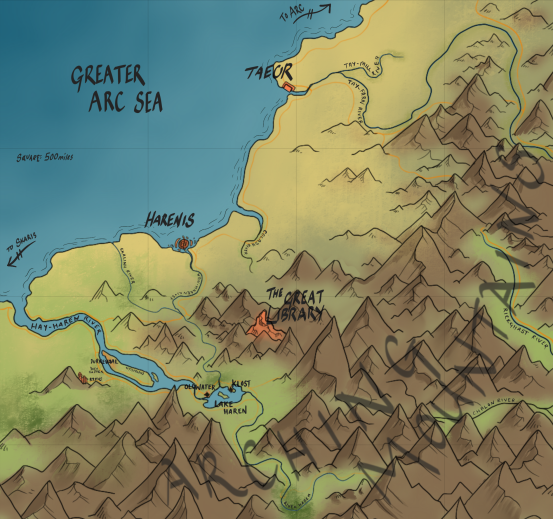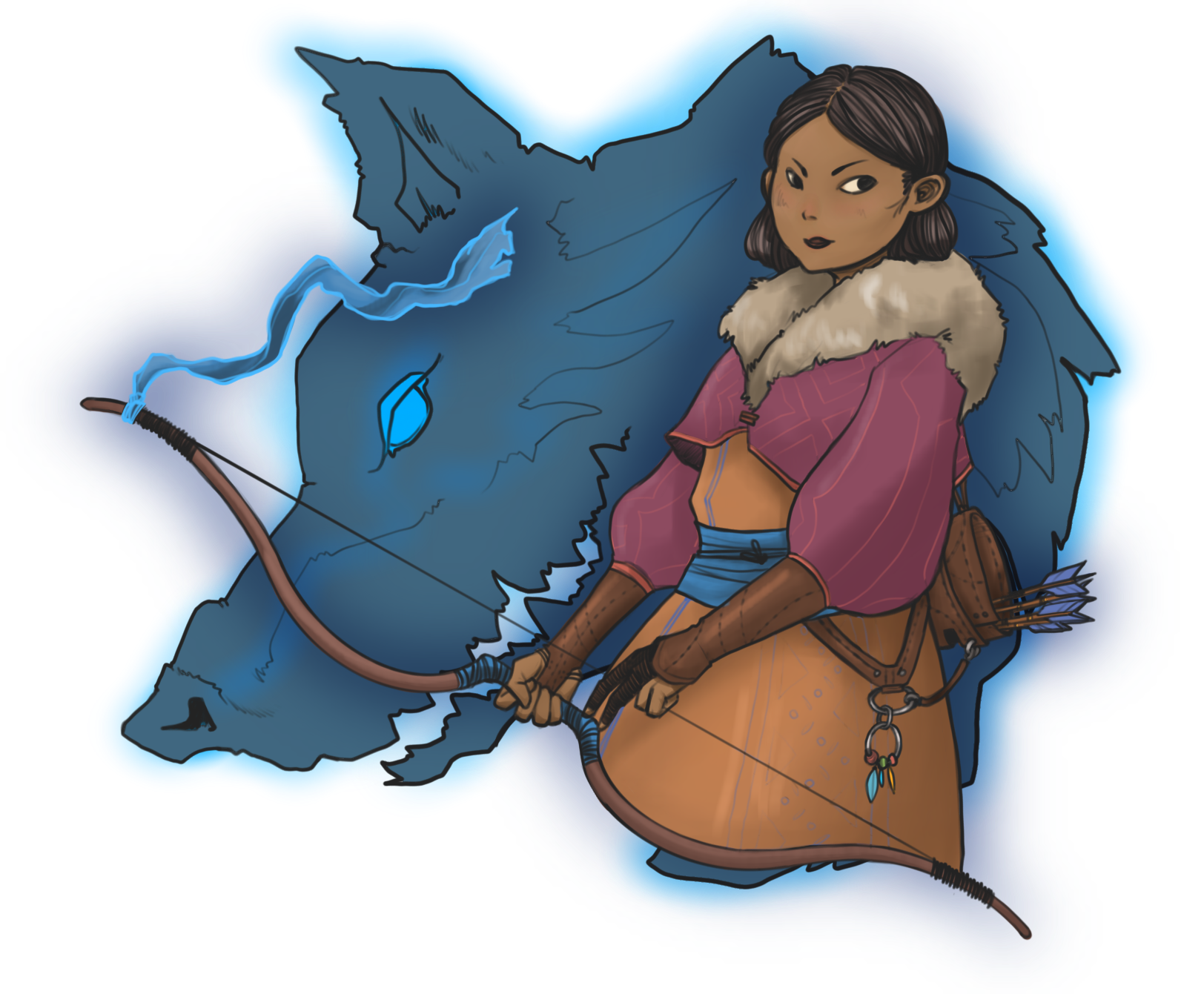Introduction
In the vast, rolling plains east of the Mill lands reside a tribal people known as the Haatchi; an expert warrior race , whose lands are surrounded by enemies and rivals. Neighboured by Wardenhal and Hothis, the Haatchi lay claim to all land between the Mill Lands, Del Vettor and the Arching Mountains.
There are five main Haatchi tribes, and hundreds of lesser clans that are allied to the great chieftains of the ruling tribes. The five live in relative harmony with one another, divided only by geography. While some tribes reside on the plains, others dwell in the mountains.
The Haatchi are a proud and fiercely independent people who have lost territory over the centuries to the Swithick people of the Mill Lands. Some Haatchi lords dream of re-claiming the lands lost to the Swithicks, whereas others recognise that the Mill Lands are a source of wealth for them and, even though they dislike the Swithick people, they understand their value as traders.
The Haatchi look upon the great cities along the coast of the Arc Sea with immense suspicion, seeing any urban dwelling peoples with great access to military power as inherently dangerous. Of all the cities along the coast they mistrust, however, it is Skaris that presents the greatest danger as far as the Haatchi are concerned.
Skarisi priests and missionaries who have been caught in Haatchi territory attempting to convert Haatchi villages from their twin faiths (the Lord of the Mountains and the Lady of the Plains), have also revealed under duress that they have been looking for routes across Haatchi lands. Despite being left in icy lakes with blood leeches and being tied on top of fire ant mounds, the Skarisi are yet to explain precisely what they are up to.
Horses
The great skill of the Haatchi is in horse rearing and riding, Haatchi tribes keep the best stallions and mares for themselves and sell their offspring to the highest bidder; owning a Haatchi horse is second only to owning a Firg sword. Great herds of Haatchi horses are taken each year from the plains of the central Haatchi territory to Tenguri, the city at the confluence of the Nao and Anam Rivers which stands in the distant shadow of the Orne Mountain.
The arrival at Haatchi mid summer (the festival of Negu, ‘the blessing of the lady’) of thousands of horses ready to sell is called the ‘Summer Thundering’, given the noise across the Tenguri plain that so many animals make. Lords, nobles and knights looking to buy horses travel for hundreds of miles to Tenguri each summer to buy a Haatchi stallion or mare. Haatchi horse traders will rarely sell to just anyone; being parted from one of their herd is like losing a close family member (with some Haatchi, it is even more heart rending than this, as many tribes are deeply divided), so any prospective buyer must demonstrate a high level of care and concern for the horse. Mordikhaani and their allies in the Black Republics are of course unwelcome here, as are Skarisi. Swithicks are tolerated but will invariably be sold older, less reliable horses if only to prove that the great trading people to the west aren’t quite as clever as they think they are. Haatchi, whether within their own lands or travelling, see themselves as the natural protectors of horses and will draw swords against anyone who mistreats them.
Haatchi Villages
Haatchi villages are known as Nagura, which roughly translates as ‘halls of belonging’, and they have a special and sacred place in Haatchi culture. The Nagura are built on large earthwork hills and surrounded with concentric circles of stone walls to stop enemy cavalry. At the centre of the Nagura is the circular Nagude, or chieftain’s lodge. The lodges are constructed by excavating a circular section of soil and building a hearth in the centre with walkways down the side of the pit. Around the edges of the excavation, stone walls are built and canvas or thatched conical roofs are then added on top, with smoke holes to release fumes from the hearth. Surrounding each Nagude are the smaller lodges of the chieftain’s warriors, which symbolise the protective circle the warriors make around their chief in battle. Fanning out from this inner circle of dwellings are the stables, tanneries, smoke houses, smithies and fletchers cottages that comprise a Haatchi settlement. In between these houses are small shrines to the two Haatchi gods, the Lord of the Mountains (Orejk) and the Lady of the Plains (Darejk).
Haatchi Culture
The Lord of the Mountains (Orejk) and the Lady of the Plains (Darejk), in Haatchi culture, were siblings who were the progenitors of the Haatchi people. Haatchi wind singers, the keepers of lore for the different tribes, tell that the brother and sister came forth at the beginning of the world when the land was covered in a grey mist. They shaped the mountains and breathed life into the valleys and steppe and from those early beginnings, all life flowed. Haatchi often refer to their gods as the first woman and the first man, and they believe that their gods will be present at the end of the world as well as its creation. During the ‘beginning time’, a spider, Yolugoth, also scuttled into the world and began to work its mischief, creating many wicked enemies for the Haatchi to fight. It created greed, lies, jealousy and anger, working through other humans to achieve its ends, but it also created the monsters that once populated Haatchi territory, but which have now been expelled to the edges of Haatchi lands and deep into the Arching Mountains. Haatchi wind singers perform daily rituals along the walls of Haatchi villages to keep Yolugoth at bay. Outsiders look upon the tales of Yolugoth as a foolish superstition, but the wind singers of the Haatchi are deadly serious about its evil presence.
The Haatchi make use of long, poetic and complicated songs to explain their world. They are different to the historical sagas performed and sung by the Ghotharic Skalds and are incomprehensible to outsiders. They have a non linear form and often feature the nature, the elements and the history of the Haatchi people.
(Secret: Orejk, Darejk and Yolugoth were all graces. They didn’t create the Haatchi but have influenced them throughout their history).
The Tribes of the Haatchi
The Ur Haatchi
A growing power within the Haatchi lands is the mountain tribe, the Ur Haatchi. They have a long standing alliance with the Firg and will cross over into the northern Mill Lands and Welland to meet with their allies in the Firg Kingdom periodically. The Ur Haatchi see crossing the Mill Lands as their right and are openly contemptuous of all non Haatchi. They have an uneasy stand off with the Northern Border Horse of the Mill Lands; even though they outnumber them, they recognise the border horse are formidable warriors and are perhaps the only Swithicks worthy of recognition. They visit Tenguri in the summer and ride back to the Thodanei Mountains south of Hothis in the winter where they have built homes and shelter for their horses deep in the mountain caves with Firg help.
The San Haatchi
The plains tribe that suffered the most when the Swithicks expanded in the Mill Lands was the San Haatchi. They have often been thought as the least warlike of the Haatchi and they were forced to concede most of their ancestral territory along the Shay Valley. Other Haatchi saw them as weak and concluded that if they had fought for their territory they might have had a chance of avoiding humiliation (for themselves and the rest of the Haatchi peoples). As such their standing among Haatchi tribes is low. They are skilled herbalists and healers, but are often accused of using their skills to create poisons and carry out assassinations against their enemies among the Haatchi and the outside world.
The Dar Haatchi
The Dar Haatchi are the poorest and smallest of the Haatchi tribes, living in the foothills of the Thodanei mountains. They are brave warriors and come under the protection of the Ur Haatchi, but in recent years this has become less a relationship based on protection than one based on servitude. The Dar Haatchi are used by the Ur Haatchi for labour and to fight for the Ur when required. They accept this fate without complaint, knowing that to refuse the orders of a greater lord is a deep dishonour.
The Jora Haatchi
The Jora Haatchi were once the greatest tribe of the Haatchi people, their riders charged at the front of every Haatchi army and they took the glory of defeating their enemies in battle. In **, the Haatchi rode alongside the Firg to save Wardenhal from the Khul (their real interest was in stopping Mordikhaan advancing southwards into Haatchi territory). They smashed through the Khul’s armies but the black magic of her servants, the Norns, devastated the Jora and the tribe lost its fighting potential for generations. The Jora Haatchi are revered as great warriors but as a people they are a shadow of their former selves and Jora chiefs desperately search for ways to rebuild their people.
The Drah Haatchi
The Drah Haatchi are clever traders and barterers. They live closest to Del’Marah and Del’Vettor and are the main traders with the South. They are the most nomadic of the Haatchi and they have previously fought for the Emperor of Del’Marah as mercenaries and have periodically fought against the southern empire when an expansionist emperor has eyed Haatchi territory. They are often disrespected by the other Haatchi but are ultimately seen as being an extremely valuable way to protect the southern borders.
The Orne Mountain and the Rao Haatch
i
Five hundred years ago, a sixth tribe of the Haatchi vanished. The Rao Haatchi, traditionally the keepers of the secret stories of the Haatchi people, who’s healers and spirit talkers were able to tap deep into what little magic there was in the world, rode into the shadow of the Orne Mountain and were never seen again. Whilst looking towards the figure of the Rider, who sometimes is seen standing on the ledges of the Orne Mountain, some Dream Seekers claim they have seen the banners of the Rao Haatchi fluttering in the distance. Many Haatchi believe that the Rao are lost somewhere between this world and another, and the Rider holds the key to their fate and to that of the Haatchi people overall.
Tenguri
The Haatchi city of Tenguri serves only as a capital to the Haatchi people when all the tribes are gathered, usually in a time of crisis. It is an ornate but functional hilltop fortress on the Tenga, a huge rock that rises from the plains. A town is built at the foot of the Tenga, but it is often more or less deserted. When all the tribes are gathered, the Tenga is surrounded by many miles of tents and yurts and hundreds of tribal banners blow in the breeze. Tenguri is also the site of one of the most sacred places of the Haatchi, Do Aran, the shrine to the Lady of the Plains. The followers of the Lord of the Mountains do not waste time on shrines, to them, the mountains themselves are the most sacred of places.
Do you want more lore? Get weekly updates on World Anvil and the Arclands Blog straight to your email inbox, PLUS our list of fifty mysterious trinkets to delight and enchant your adventuring party. Get your copy here.




























Comments